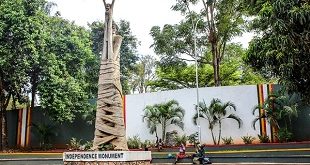
Kampala, Uganda | THE INDEPENDENT | As the fight for followers intensifies, different Christian denominations are engaged in another struggle over liturgical vestments. Setting a definitive stance, the Church of Uganda has officially gazetted its attire as a safeguard against potential misuse or misappropriation by clergy from other denominations and sects.
Rev. Canon William Ongeng, the Provincial Secretary of the Church of Uganda, observes that over time various denominations, particularly Pentecostals, have been wearing the Church of Uganda’s vestments, which has led to confusion among followers and misuse of these items.
To address this issue, he explains that the Church has decided to formally document and protect their liturgical attire. Initially, they began by gazetting the 42 episcopal vestments used by the Archbishop and Bishops, which Ongeng notes are the most commonly misused.
In Christian worship, vestments are liturgical garments and accessories found primarily in the Eastern Orthodox, Catholic (both Western and Eastern rites), Anglican, and Lutheran traditions. The design and color of each vestment are rich in spiritual symbolism, reflecting various elements of Christian faith and worship including seasons, and kinds of service among others. The vestments also symbolize order, office, and role or function.
According to the public notice issued by the Church of Uganda, some of the trademarks that have, so far, been registered include bishop’s Mitre, Rochet, and Chimere, as well as the Alb, Cassock, Surplice, Stole, and Chasuble.
In Uganda, the debate over the misuse of vestments has been a hot topic, especially within the church of Uganda Church and among certain Pentecostal groups. These Pentecostal denominations have increasingly adopted the Anglican clerical dress code for both services and secular activities, sparking controversy and discussion.
For instance, there has been a growing trend among Pentecostal ministers to adopt the purple clerical shirt traditionally worn by Anglican bishops. A notable incident in 2022 occurred when Dr. Joseph Sserwadda, head of Victory Church in Ndeeba, and Pastor Nathan Ibrahim Turyamureeba appeared dressed in Anglican-style episcopal attire during a consecration ceremony.
This event sparked controversy, with the Church of Uganda condemning the practice as a misuse of their clerical vestments. In response, the Archbishop of the Church of Uganda formed a committee, headed by Rt Rev. Prof. Alfred Olwa, the Bishop of Lango, to investigate the misuse of Anglican liturgical vestments and other related aspects of church practice, including music.
According to Rt Rev. Prof Olwa, the Church of Uganda has sought the assistance of the Uganda Registration Services Bureau (URSB) to register their vestments as trademarks and intellectual property rights to prevent their misuse. The registration for bishops’ vestments has been finalized, and they are now working on registering vestments for priests, canons, and lay readers.
With the completion of the registration process, The Provincial Chancellor Naboth Muhairwe, added that the Church is preparing to enforce these rights, which involves informing the public that misuse of these registered items could result in legal action, including civil suits or criminal charges, as prescribed by the Trade Mark Act and related legislation.
Naboth Muhairwe has emphasized that individuals or groups who wish to use the Anglican vestments for any reason—whether for artistic, filmmaking, or other creative projects—must seek permission from the Provincial Secretary of the Church of Uganda. This requirement ensures that the use of these sacred vestments is properly regulated and aligns with the Church’s standards.
According to the Trademarks Act of 2010, an individual who forges or counterfeits a trademark with the intent to deceive or help another person deceive others is committing a criminal offense. Upon conviction, the person may be subject to a fine not exceeding forty-eight currency points, imprisonment for a maximum of two years, or both.
With the increasing occurrence of their items being used in unauthorized ways. Different churches in different countries have over the years been registering some of their items including logo, crosses, patterns and designs used as intellectual property and trademarks.
Meanwhile, South Ankole Bishop Rt Rev Nathan Ahimbisibwe advised Pentecostal ministers to respect established traditions while also exploring their paths in clerical attire. He rather challenged them to design their distinctive clerical vestments rather than using those associated with the Church of Uganda.
“Wearing the vestments of the Church of Uganda while being affiliated with a different denomination is unacceptable,” Bishop Ahimbisibwe stated. “We encourage other Christian groups to develop their unique attire, as the vestments we have designated are specific to our church and should not be used by others.”
The bishop elaborated that the Anglican and Roman Catholic churches each have their unique vestments, and these differences do not cause contention. He highlighted the importance for Pentecostal ministers to create or adopt clerical garments that reflect their distinctive traditions.
Historical background
Throughout the Protestant Reformation and even into the nineteenth century, vestments were a significant source of contention, especially evident during the Ritualist controversies in England. Records show that some churches viewed elaborate vestments as “symbols of the tyranny of the Bishop of Rome” and instead chose simpler black gowns or even civilian dress, such as a shirt and tie.
Traditionally, Pentecostal ministers have eschewed the use of vestments, preferring instead to wear formal suits or other attire that signifies their dedication to the worship of God. Nonetheless, Abraham Modisa and Mkhondo Mzondi’s research highlights a shift in this trend, noting that the practice of using clerical vestments became more prominent in African Pentecostal-Charismatic Churches following the consecration of Gladstone Botswana, founder and head of Zoé Bible Church in Soweto, as a bishop in 1996. Since then, the use of clerical vestments has become a standard practice within these churches.
****
URN
 The Independent Uganda: You get the Truth we Pay the Price
The Independent Uganda: You get the Truth we Pay the Price






